Children
What do these photos tell you about how Indian children grew up?
An Ute Boy On His Pony
The boy on the horse is an Ute Indian. The photo was taken around the year 1900, probably on the Southern Ute Reservation.
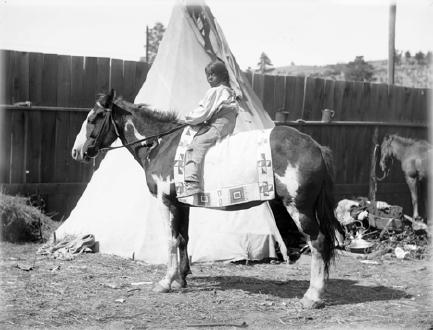
Photo: Denver Public Library, Western History Collection
More About This Topic
Indian boys learned to ride horses almost as soon as they learned to walk. They spent a lot of time around horses. Their main chore was to guard their village’s herd of horses. They had to warn the adults in case of raids by other Indian tribes.
Their Own Words
"We all played at living in camp. In these camps we did the things that older people do. A boy and girl pretended to be husband and wife, and lived in the lodge; the girl cooked and the boy went out hunting. Sometimes some of the boys pretended that they were buffalo, and showed themselves on the prairie a little way off, and other boys were hunters, and went out to chase the buffalo. We were too little to have horses, but the boys rode sticks, which they held between their legs, and lashed with their quirts to make them go faster."
Source: George Bird Grinnell, When Buffalo Ran (New Haven, 1920), p. 21-22., As remembered by Wikis, a Cheyenne boy.
Ute Girl
This is a photo of Mary Buck, a Ute girl. It was taken about 1900, when the Utes lived on a reservation in southern Colorado. She is holding a doll in a small cradle board.
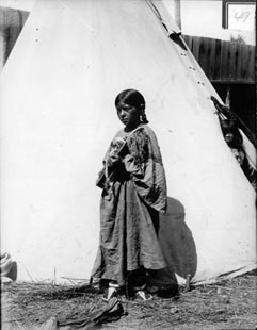
Photo: Colorado Historical Society
More About This Topic
Indian girls liked to play with dolls and to build “play lodges,” pretending they were grown up. Playing helped them practice many of the skills they would need later in life.
Their Own Words
"In these larger camps, we children had much fun, playing our different games. We had many of these....Often the little girls caught some of the dogs, and harnessed them to little travois, and took their baby brothers and sisters, and others of the younger children, and moved off a little way from the camp, and there pitched their little lodges."
Source: George Bird Grinnell, When Buffalo Ran (New Haven, 1920), p. 21-22, as remembered by Wikis, a Cheyenne boy.
A Plains Indian Doll
This doll belonged to a plains Indian girl. She is wearing a muslin dress decorated with beads. Her leggings also are made of beads. The doll was made sometime after 1860.
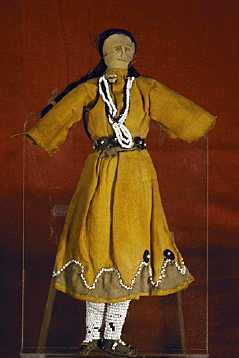
Photo: Colorado Historical Society
More About This Topic
The dolls that Indian girls played with were made from materials close at hand. The doll’s hair was usually made of horse hair. Its clothes were made of animal skins or, later on, of cloth. Indian dolls also were made of reeds, wood, and tree bark.
Their Own Words
"Fathers and mothers made fine toys for their children. For their little girls, Arapaho mothers made dolls dressed in perfect buckskin costumes, beaded and fringed just as our own costumes were. The tiny moccasins these dolls wore were made as carefully as moccasins for people."
Source: Althea Bass, The Arapaho Way: A Memoir of an Indian Boyhood [by Carl Sweezy] (New York: Clarkson N. Potter, Inc., 1966), p. 35.
Ute Boy
This is a Ute boy. He is standing on a blanket in front of a tepee. He is dressed in traditional Ute clothes. He is wearing a pipe breast plate, a beaded necklace, leggings, and beaded moccasins.
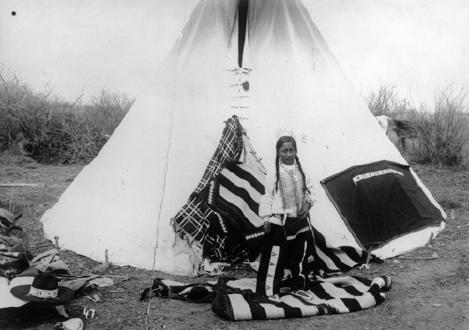
Photo: Denver Public Library, Western History Collection
More About This Topic
Indian children wore clothes that looked like adult clothes. Boys wore shirts, leggings and moccasins made of deer skin. Girls wore deer skin dresses that looked a lot like those their mothers wore.
Their Own Words
"Fathers made bows and arrows for their sons, and made them so true that little boys could bring down squirrels or birds with them. Sometimes the boys dressed the squirrel they had shot, and cooked and ate it, and then sat around their fire telling their “buffalo story,” as if they were old hunters."
Source: Althea Bass, The Arapaho Way: A Memoir of an Indian Boyhood [by Carl Sweezy] (New York: Clarkson N. Potter, Inc., 1966), p. 35.
Ute Girls Dressed Up
The girls in this photo are Ute Indians. They are dressed up, wearing long dresses, earrings, and bracelets. One girl’s dress is made of deer skin, the other of cloth.
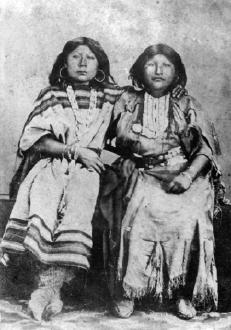
Photo: Colorado Historical Society
More About This Topic
Indian clothing styles changed over time. After the Indians began trading with whites, cloth was easier to get than deer skins. By the late 1800s, most Indian men and women wore clothing made of cloth.
Carrying Water To Camp
The child in this photo is helping a woman carry water from a river to their village.
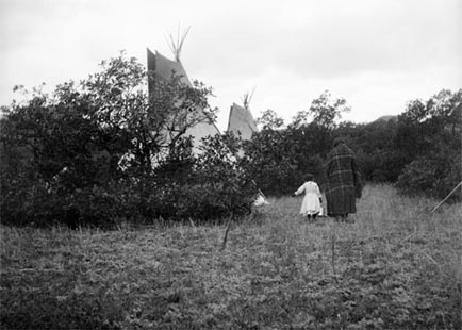
Photo: Denver Public Library, Western History Collection
More About This Topic
Girls learned how to do women's work by helping out when they were young. The girl in this was too young to carry very much water. But helping out was a good way to learn how it was done.
Their Own Words
"Because we have no schools, like the white people, we have to teach our children by telling them what to do; it is only in this way that they can learn... Their relations, therefore, talk to the children.... My grandfather was an old man, who long before this had given up the warpath. He spent most of his time in the camp, and he used to make speeches to the little and big boys, and give them much good advice."
Source: George Bird Grinnell, When Buffalo Ran (New Haven, 1920), p. 29-30. As remembered by Wikis, a Cheyenne boy.

